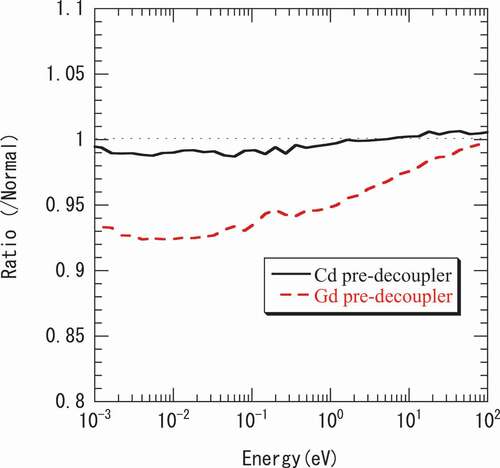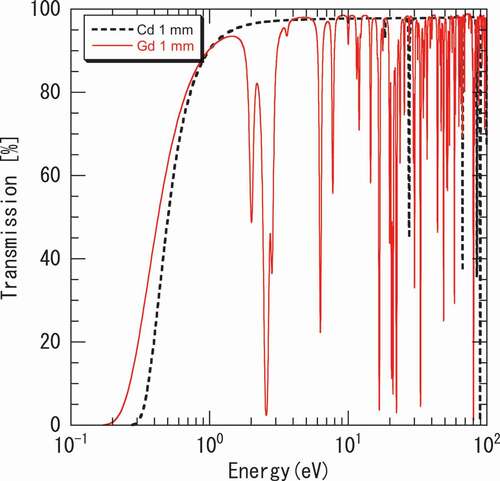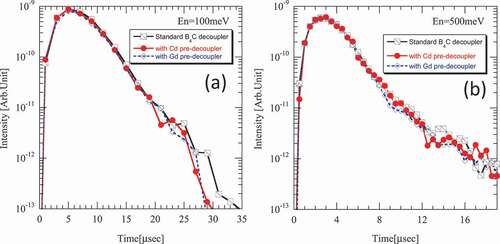ABSTRACT
In pulsed neutron sources, a neutron absorber called decoupler, which is characterized by a decoupling energy (Ed), is attached to the moderator to sharpen the neutron pulses for achieving good neutron energy resolutions. Cadmium and boron carbide (B4C) are widely used as the decoupler materials. However, it is difficult to use B4C in MW-class spallation neutron sources owing to high burn-up, which decreases Ed and increases helium gas swelling due to neutron absorption. To solve these issues concerning a B4C decoupler, we introduce the concept of pre-decoupler to reduce neutron absorption in the B4C decoupler, which is sandwiched by appropriate neutron absorption materials. Then, we study impacts of the pre-decouplers on B4C decoupler in terms of burn-up by performing simplified model calculations. It is shown that neutron absorption in B4C is reduced by 60% by using a Cd pre-decoupler without neutron intensity penalty. Moreover, helium gas swelling in B4C is restrained to be one-third of the value when not using the pre-decoupler.
1. Introduction
In moderator design for pulsed neutron sources, decoupled moderators play an important role in sharpening the shapes of neutron pulses. Here, the decoupler is defined as a neutron absorber attached to the moderator, and it prevents entry of slow neutrons from a reflector into a moderator for restraining the neutron pulses to be broadened. Moreover, the decoupler is characterized by a decoupling energy (Ed), where the neutron transmittance becomes 1/e. Cadmium (Cd) and boron carbide (B4C) are used widely as decouplers [Citation1–Citation4]. The decoupling energy, Ed, of Cd is approximately 0.4 eV, because its neutron absorption cross section rises steeply below 0.4 eV. The effective Ed of B4C increases with increase of B4C thickness because the neutron absorption cross section of boron follows the 1/V law [Citation5]. Notably, however, the effective Ed decreases with increase of the neutron absorption in B4C. We call this process ‘burn-up’ in the present study. As burn-up speed is expected to be high, especially in a MW-class neutron source, B4C burn-up is a critical design parameter when B4C is used as the decoupler. In the J-PARC MW pulsed spallation neutron source [Citation6], moderator lifetime has been determined to be 6 years from radiation damage due to displacement per atom (DPA) in Al-alloy moderator vessel materials [Citation7]. In the J-PARC neutron source, an Ed of 1 eV is requested by the J-PARC user group. In addition, boron produces helium via the 10B(n,α)7Li reaction, which leads to an increase in the amount of helium gas in the decoupler, causing swelling and cracks. To solve these issues associated with burn-up and helium gas swelling in B4C, an Ag-In-Cd alloy (AIC) decoupler [Citation5,Citation8], was developed and installed in the J-PARC neutron source. AIC was made to exhibit a smooth neutron absorption characteristics similar to 1/V law. Then the large neutron absorption of Cd and the giant resonance cross sections of silver at 4.89 eV and indium at 1.47 eV are combined. Although AIC performed well as the decoupler with an Ed of 1 eV, there was a penalty in maintenance owing to high radiation doses originating from the induced radioactivity of 110mAg as an additional issue in terms of the need to use a heavy γ-ray shielding structure.
Nevertheless, B4C is attractive because it can control the Ed by its thickness, and the associated radioactivity is considerably lower than that of AIC. Thus, we investigated the possibility of using the B4C decoupler withstand in MW-power by introducing a concept of a pre-decoupler made of Cd or Gd, which sandwiches the B4C decoupler, to reduce B4C burn-up based on simulation calculations. With the pre-decoupler, He gas swelling of the B4C is estimated from the available irradiation data of nuclear reactors.
In the present study, we describe the result of the effect of the pre-decoupler on burn-up of the B4C decoupler from a viewpoint of neutronic performance in the pulsed spallation neutron source with the geometry implemented at J-PARC, along with estimation of helium gas swelling in B4C [Citation5].
2. Simulations
2.1. Simulation method
The code PHITS ver. 2.8.8 [Citation9] is employed to execute simulation calculations throughout this study. The cross section data library JENDL4.0 [Citation10] is used for all materials, except para-hydrogen, the data of which are taken from ENDF/B-VI [Citation11].
shows a schematic drawing of the target moderator reflector assembly of the neutron source. The neuron production target is mercury with dimensions of 200 × 100 × 750 mm3. Two layers of SS-304 stainless steel walls are used as target vessel. The proton beam of 3 GeV is injected into the mercury target to produce neutrons via the spallation reaction. We assume a Gaussian distribution for the proton beam profile with the FWHM of 40 mm in width and 20 mm in height. Ninety-nine percent para-hydrogen is employed as the moderator material. The dimensions of the moderator are 120 × 120 × 50 mm3. Two layer of aluminum walls are adopted as moderator vessel. The moderator is positioned above the target. The distance from the front surface of the target to a center of moderator footprint on the target along the proton beam direction is 150 mm as shown in , and this distance is considered the optimal position for the 3 GeV proton beam [Citation9]. The distance between the upper surface of the target vessel and the bottom of the moderator vessel is 31 mm. Beryllium with 5% H2O in volume is used as a reflector. The reflector shape is cylindrical with 1.2 m in diameter and 1.2 m in height. The center of the moderator is placed on the axis of the reflector. Neutron-extraction holes measuring 100 × 100 mm2 are made on both sides of the moderator. The B4C decoupler is attached to the moderator vessel made of aluminum. The B4C layer, also called the liner, is placed along the inner walls of the neutron-extraction holes [Citation5]. In the calculations, we applied a 1-mm-thick B4C layer with a density of 2.2 g/cm3, which corresponds to the Ed of 1.3 eV. Between the B4C decoupler and the reflector, a 5-mm-thick H2O layer is placed as a moderator vessel cooling water. shows density of the materials used.
Table 1. Density of the materials used in this study
Figure 1. Schematic drawing of target moderator reflector assembly. 3-GeV protons were injected into the Hg target from right-hand side with a footprint of 40 × 20 mm2. The moderator was set above the target. Neutrons were extracted from the moderator through the neutron-extraction holes.
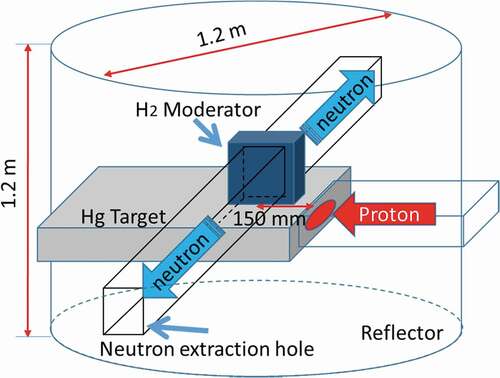
In this study, point estimator is used to obtain neutron spectrum and neutron pulse shape from the moderator. Surface tally is used for spectrum calculation of neutrons crossing a surface.
shows a conceptual structure of the pre-decoupler. As a calculation case, the B4C decoupler is sandwiched with 1-mm thick cadmium or gadolinium layers as the pre-decoupler, and this assembly is compared to the assembly without the pre-decoupler, which we define as the standard decoupler. The pre-decoupler is applied only around the moderator.
Figure 2. Cut views of a moderator center plane along neutron-extraction holes. The left figure shows the standard decoupler case, and the center figure shows the pre-decoupler case. The right shows an enlarged view of area indicated by a doted circle, and it contains details of structures with the pre-decoupler.
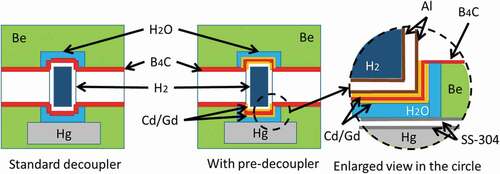
3. Results and discussions
3.1. Neutron intensity
shows ratios of the neutron energy spectral intensity from the moderator with the pre-decoupler of Cd and Gd, normalized against that of the standard decoupler. gives integrated neutrons intensity from the moderators with energy less than 0.1 eV. For the case of the Cd pre-decoupler, the neutron intensity is almost the same as that of the standard decoupler. For the Gd pre-decoupler case, neutron intensity decreases with energy, and at the energy less than 0.1 eV, the neutron intensity is decreased by 7%. This difference would be attributable to the difference of the cross-sections of Cd and Gd discussed in the next section.
Table 2. Integrated neutron intensity from moderator less than neutron energy of 0.1Ev. [×10−7 n/cm2/proton]
3.2. Neutron absorption in decoupler
shows the number of neutrons absorbed by the B4C decoupler and pre-decouplers. Neutron absorption in the liner is not included. Neutron absorption in the B4C decoupler is 2.44 neutron per proton (n/p) for the standard decoupler. When pre-decouplers of Cd and Gd are attached, neutron absorptions in the B4C decoupler decreased from 2.44 to 1.0 and 0.9, respectively. The total number of neutrons absorbed by the decouplers, including the pre-decoupler, are 8% and 14% higher than that in case of the standard decoupler, respectively.
Table 3. Number of neutrons absorbed in B4C decoupler and pre-decouplers, and neutron intensity from the moderator. Inside means neutron absorption in the moderator side pre-decoupler. Outside means neutron absorption in the reflector side pre-decoupler. Neutron absorption [n/proton], Neutron intensity [n/cm2/proton]
To investigate the effect of pre-decoupler thickness on neutron intensity and neutron absorption, we performed calculations with pre-decoupler thicknesses of 0.3 mm and 2.0 mm in addition to 1.0 mm. The results are shown in . For the Cd pre-decoupler case, neutron absorption in B4C decreased owing to use of the 1-mm-thick pre-decoupler, but neutron intensity did not change. For the Gd pre-decoupler, both neutron absorption in B4C and neutron intensity decreased. With the 2 mm thick Gd pre-decoupler, neutron intensity and neutron capture in B4C decreased by 12 % and 69% respectively compared with the standard decoupler.
Figure 4. Dependences of neutron intensity from moderator and neutron absorption in B4C on pre-decoupler thickness, shown as ratios to those of the standard case.
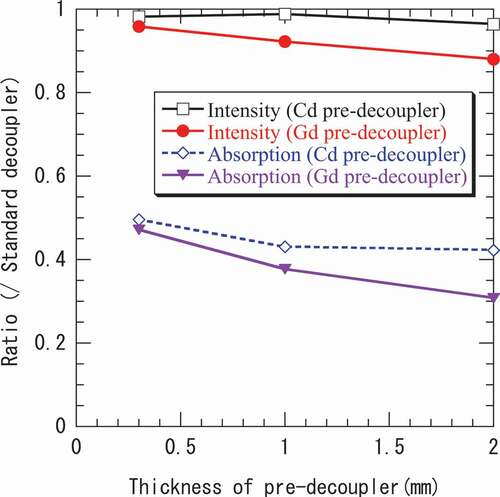
depicts a spectrum of neutrons entering into the B4C decoupler from the reflector, and a spectrum of neutrons entering into the H2 moderator after passing through the B4C decoupler, shown by thick solid line and thick dotted line, respectively. In order to realize a role of the pre-decoupler, spectra of neutrons entering into B4C from pre-decouplers of Cd and Gd, respectively, are also shown in . It is clearly shown that the pre-decouplers efficiently absorb thermal neutrons before entering into the B4C decoupler, resulting in reduction of the significant load on the B4C due to neutron absorption. Comparing the Cd and Gd pre-decoupler cases, it is indicated that the neutron flux at neutron energies around 2.5, 6.3 and 20 eV in the Gd pre-decoupler case is lower than that in the Cd pre-decoupler case.
Figure 5. Spectra of neutrons entering into the B4C decoupler from the reflector and entering into the H2 moderator after passing through the B4C decoupler. Also spectra of neutrons entering into B4C from pre-decouplers of Cd and Gd are shown.
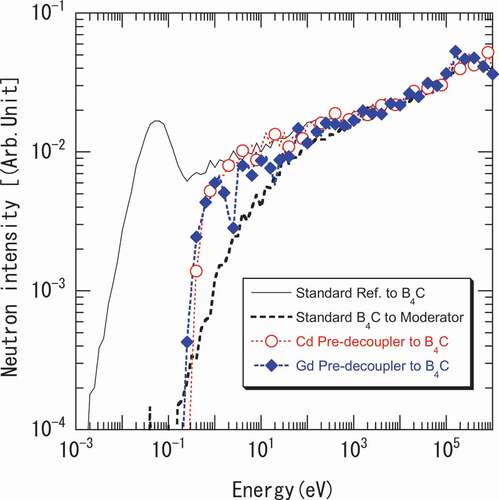
shows neutron transmission curves of Cd and Gd with a thickness of 1mm. Both Cd and Gd have very high absorption cross sections for neutron energies lower than 0.4 eV, and thermal neutrons are absorbed both by Cd and by Gd. In the neutron energy range from 2 eV to 100 eV, Gd has many resonance peaks, but Cd does not. These resonance peaks in particular at 2.0, 2.6, 6.3, 7.8 eV and other peaks in Gd, give the extra neutron absorptions comparing to the Cd case. Those neutrons absorbed are preferable to the decoupled moderator. And it leads to an intensity loss to the decoupled moderator as shown in . From the view point of the neutron intensity, Cd pre-decoupler is better than Gd pre-decoupler.
3.3. Neutron pulse shape
) show neutron pulse shapes from the moderators of the standard case and the pre-decoupler cases for neutron energies of 100 meV and 500 meV, respectively. In general, the neutron pulse shapes are characterized by peak intensity, pulse width at full width at half maximum (FWHM) and decay speed. In comparison of the pulse shapes shown in ), there are almost no difference. As it is shown in , the pre-decouplers are considered to be taking over part of neutron absorption of the B4C. Therefore, there is almost no effect on the neutron pulse shapes by the pre-decouplers.
3.4. Burn-up of B4C decoupler for pulse shape
As it was shown, the Cd pre-decoupler reduced neutron absorption in B4C from 2.44 n/p for the standard case to 1.05 n/p, which corresponds to Ed of 0.97 eV after 6 years of operation under 1 MW power. For the standard decoupler case, Ed becomes 0.4 eV after 6 years. From the requirement to keep high Ed, the pre-decoupler plays an important role. To realize the effect of burn-up on neutron performance in terms of intensity and pulse characteristics, we performed calculations with Eds of 1.3 eV, 0.97 eV, and 0.4 eV for the B4C decoupler with the Cd pre-decoupler.
) show neutron pulses at 100 meV and 500 meV, respectively, with Ed of 1.3 eV and 0.4 eV for the B4C decoupler with the Cd pre-decoupler. The pulse shape obtained with the Cd decoupler (Ed of 0.4 eV) is also shown in ) for comparison. By the burn-up, Ed changes from 1.3 eV to 0.4 eV, although pulse peak intensity increases a few percent and pulse width and pulse decay are almost same, as shown in ).
Figure 8. Neutron pulses at 100 meV (a) and at 500 meV (b) from the moderator of B4C decoupler with a Cd pre-decoupler, which have Eds of B4C are 1.3 and 0.4 eV. They are corresponding to Eds of beginning of the operation and after 6 years operations. The pulse shape for the Cd decoupler with 1 mm thickness is shown for comparison.
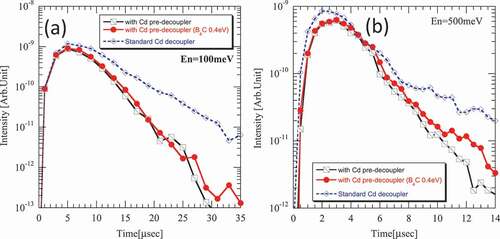
Concerning the pulse tail, the B4C decoupler with pre-decouplers give shorter decay times than that of Cd decoupler. As Ed is given for neutrons indenting vertically on a decoupler, the Ed of Cd is 0.4 eV because of a sudden increase in the neutron capture cross section at 0.4 eV. On the other hand, it is expected that effective thickness of B4C is thicker than that corresponding to 0.4 eV, because of many neutrons incident on the decoupler with an angle, resulting in a higher effective Ed and small change in pulse tail.
3.5. Position dependence of B4C burn-up
Position-dependent neutron absorption in the decoupler with respect to the neutron production in the Hg target is evaluated. The decoupler is divided into nine regions by distance from the Hg target as shown in . In regions of No. 3–7 include moderator viewed surfaces, there is no decoupler. The neutron absorption rate per volume is shown in for the standard decoupler case and for B4C with the Cd pre-decoupler case. The average neutron absorptions of the standard decoupler case and the Cd pre-decoupler case are 0.035 and 0.014 neutron/cm3/proton (n/cm3/p), respectively.
Figure 9. A schematic cut view of the moderator with B4C decoupler. The left figure shows a horizontal cut at a viewed surface region. The right shows a vertical cut along A-A’ line shown in the left figure. Numbers in the right figure are corresponding to regions from bottom to top. Width of each region is shown in the right.

Figure 10. Position dependent neutron absorption in B4C decoupler. Numbers in the horizontal axis are corresponding to the regions given in .
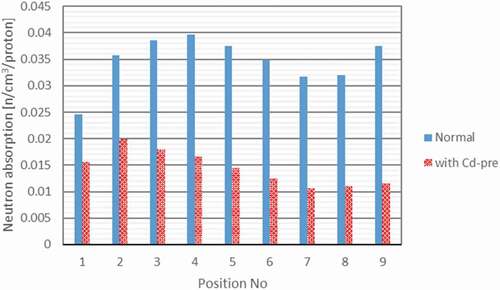
For the standard case, neutron absorption is the strongest in the region No. 4. For the Cd pre-decoupler case, neutron absorption rate of 0.02 n/cm3/p is the strongest in the region No. 2. The peak absorption with the Cd-pre-decoupler is lower than in any region in the standard case. Neutron absorption rate in the region No.2 corresponds to 1.5 n/p and is lower than the burn-up of 2.5 n/p in the normal case. As shown in , the burn-up of B4C with the pre-decoupler is negligible for the neutron pulse characteristics considering position-dependent B4C burn-up.
4. Consideration of helium production
Neutron irradiation effects on B4C have been investigated widely because B4C is one of the major materials used for control rods in nuclear reactors [Citation12,Citation13]. Here, we have taken data reported by Maruyama et.al [Citation12] to estimate the effect of neutron absorption in the decoupler. The density of neutron absorption given by Maruyama et.al [13] is between 5×1020/cm3 and 1.7×1022/cm3, which is comparable to that in this study. The He gas swelling of B4C can be expressed as 5% increase in the B4C volume when 1022 neutron capture per 1 cm3 occur [Citation12].
In this study, B4C density is 2.2 g/cm3, and decoupler volume is 71.5 cm3. The total amount of 10B is 1.37 × 1024. The number of protons entering the target is 2.24 × 1023 at 30,000 MWh, and it is approximately equal to the number of neutrons absorbed by 10B in the case of B4C with the Cd pre-decoupler, which is the base configuration in the present study. In this geometry, neutron capture in B4C is 3.1 × 1021/cm3. Taking into account of the results for position dependent neutron absorption in the B4C shown in , the maximum absorption rate is about 30% higher than that of the average. Thus, gas swelling of B4C is expected to be 2.0 % for the Cd pre-decoupler case. Moreover, the number of neutrons captured is more than 1021/cm3, meaning that the crack are expected to appear in the B4C decoupler [Citation12,Citation14,Citation15].
As He gas release from the B4C, it is suggested that almost all He remained in the B4C, and gas release is considered to be lower than 10% under temperatures of 100°C [Citation12].
With neutron irradiation, the thermal conductivity of B4C decreases quickly. The thermal conductivity of B4C decreases from 28 W/m/K to 10 W/m/K with only 2 × 1020 captures/cm3 [Citation12], which corresponds to 84 days of operation at 1 MW, and it decreases to 3 W/m/K with 3 × 1021 captures/cm3. At the neutron source of the J-PARC, the maximum heat deposition in the decoupler was estimated to be 5 W/cm3. This corresponds to the temperature gradient of 17 K/mm in the B4C decoupler.
When B4C is used as the decoupler in the MW-power spallation neutron source, it could crack within its lifetime of 6 years. According to the results of Ref.13, even if there is a crack, the solid shape of B4C with the pre-decoupler can be possibly maintained over its lifetime. As a result, the B4C decoupler with the Cd pre-decoupler is considered to be a viable concept for MW-class spallation neutron sources.
5. Summary
We showed that the burn-up rate of B4C can be reduced by 60% with a Cd pre-decoupler, keeping the same pulse characteristics and intensity in the standard case without any pre-decoupler. Also, the reduction of the He gas swelling of the B4C decoupler is expected.
Acknowledgments
We would like to thank the members of the neutron source section of J-PARC for their support on this work.
References
- Watanabe N, Ikeda N, Ishikawa Y. KENS Target station. Proc. 4th Mtg. International Collaboration on Advanved Neutron Sources (ICANS-IV); 1980 Oct 20–24; Tsukuba (Japan): KEK. p. 181.
- Swanson NJ. IPNS-1 Status of IPNS Construction. Proceedings of 4th Mtg. International Collaboration on Advanved Neutron Sources (ICANS-IV); 1980 Oct 20–24; Tsukuba (Japan): KEK. p. 131.
- Morse FA Status of the Commissioning of the Los Alamos Neutron Scattering Center, LANSCE. Proceedings of 8th Mtg. International Collaboration on Advanved Neutron Sources (ICANS-VIII); 1985 July 8–12; Oxford (UK): RAL. p. 55.
- Carne A. Review of SNS Target Station. Proc. 4th Mtg. Int. Collaboration on Advanved Neutron Sources (ICANS-IV);1980 Oct 20–24; Tsukuba (Japan): KEK. p. 136.
- L A C, J M B, Johnson J,O, et al. SNS Neutronics Studies. Proceedings of 14th Mtg. International Collaboration on Advanved Neutron Sources (ICANS-XIV); 1998 June 14–19; Utica Illinoism; 678
- Harada M, Watanabe N, Teshigawara M, et al. Neutronic studies on decoupled hydrogen moderator for a short-pulse spallation source. Nucl Instrum Methods Phys Res A. 2005;539:345–362.
- Ikeda Y. J-PARC status update. Nucl. Instrum. Meth. Phys. Res. A. 2009;600:1.
- Norgett MJ, Robinson MT, Torrens IM. A proposed method of calculating displacement dose rates. Nucl Eng Des. 1975;33:50–54.
- Harada M, Saito S, Teshigawara M, et al., Silver-Indium-Cadmium decoupler and liner. Proceedings of 16th Mtg. International Collaboration on Advanved Neutron Sources (ICANS-XVI); 2003 May 12–15; Dusseldorf-Neuss (Germany). p. 677.
- Sato T, Iwamoto Y, Hashimoto S, et al. Features of Particle and Heavy Ion Transport code System (PHITS) version 3.02. J Nucl Sci Technol. 2018;55:684–690.
- Shibata K, Iwamoto O, Nakagawa T, et al. JENDL-4.0: A New Library for Nuclear Science and Engineering. J Nucl Sci Technol. 2011;48(1):1–30.
- MacFarlane RE New Thermal Neutron Scattering Files for ENDF/B-VI Release 2. Los alamos national laboratory report LA-12639-MS. 1994
- Maruyama T, Onose T, Kaito S, et al. Nucl. Sci Technol. 1997;34(10):1006–1014.
- Donomae T, Maeda K. Fast Spectrum Control Rod Materials. Compre Nucl Mater. 2012;3:509–534.
- Stansfield OM. Irradiation induced dimensional change in boron carbide. J Nucl Mater. 1969 Jul;31(3):351–355.
- Froment K, Gosset D, Guéry M, et al. Neutron irradiaton effects in boron carbides: evolution of microstructure and thermal properties. J Nucl Mater. 1992 Jun;188:185–188.

